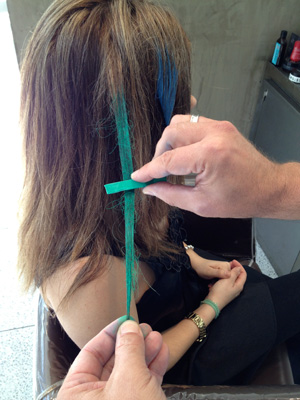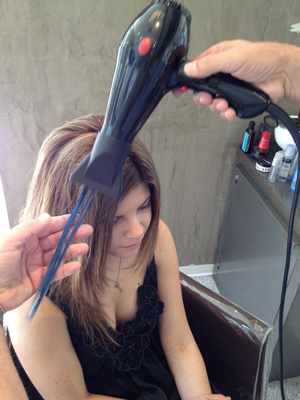When Ben Ownby heads to the pool, he has a furry associate in tow:
Dakota the dog,
who actually follows Ben everywhere, including class and social events.
Dakota’s not there for play, but to provide Ben with a vital service.
He’s a diabetic alert dog who can tell when Ben’s blood sugar is too low
or too high, and signals Ben to tell him to check his levels and take
appropriate measures to get them under control. Ben, a type 1 diabetic,
can’t rely on an insulin pump and monitor to help him manage his
condition because of adhesive allergies, so he depends on Dakota to keep
his diabetes at bay.
Meet the new breed of assistance animal. While you might think of
guide dogs for blind and visually impaired people when you hear the term
“assistance animal,” animals can actually be trained to perform a wide
variety of tasks for their disabled partners, and the vast majority of
assistance animals are dogs. (In fact,
recently revised guidelines
legally limit service animals to dogs and trained miniature horses.)
These animals help their partners achieve independence, and come to play
an important role in their lives.
Dakota is an example of a diabetic alert dog, a type of service
animal that’s becoming more common as people take advantage of the fact
that dogs can smell changes in blood sugar level. Dogs aren’t the only
animals that can do this;
Elijah the cat
is equally capable of noticing changes in blood sugar levels and
signaling them to his human. Service dogs can also help people with
epilepsy and other seizure conditions, where a
seizure dog
can detect early warning signs of a seizure and provide assistance that
can include fetching medication, pressing a button to summon
assistance, rousing handlers and “blocking,” physically obstructing
their handlers so they don’t accidentally fall down or enter a dangerous
area (like the street).
Hearing dogs, meanwhile, help
D/deaf and hard of hearing people by alerting them to audible cues in the environment that they can’t hear. Julia, for example,
alerts her partner Janet
to the doorbell, the teakettle, the alarm and other noises around the
house so Janet can respond. Junior helps her partner Tanya by letting
her know when the baby or another one of the children needs assistance,
keeping an “ear,” so to speak, on the kids so Tanya knows they’re safe.
Psychiatric service dogs
can help their handlers by performing a wide variety of tasks that help
them manage their disabilities. These tasks are highly specialized,
depending on the handler’s needs; for example, a PTSD dog might run
through a home or room to “clear” it, checking for hazards, before her
partner enters. PTSD dogs can also guide medical responders to a handler
in crisis, bring medications, or
keep handlers centered
when they’re in a stressed state. Other psychiatric service dogs can
remind handlers about medications, interrupt self-harming behaviors and
perform related actions.
Mobility dogs can help
stabilize people
who have trouble walking independently, or pull wheelchairs for
handlers who need assistance. Other assistance dogs fetch water bottles
and other supplies on command to help their handlers, and can also
perform tasks like turning lights on and off, opening doors, and more.
In all cases, service animals perform specific tasks to help a person
with a disability, offering a service that the disabled person couldn’t
perform independently. They aren’t pets, therapy animals, or emotional
support animals, but working animals on the job, helping their owners
retain independence and build confidence. The expansion of service
animal handling and training to include a wide variety of disabilities
in recent years has radically changed the scope of the landscape for
disabled people.
It’s also created some issues, however. As service animals get more
prominent, increased confusion about what they do and legal requirements
when it comes to accommodating them has arisen. Legally, service
animals must be accommodated as long as they are not disruptive (i.e.
poorly-trained), and while their handlers can be asked about which tasks
the animal performs, they are not required to provide documentation or
discuss the nature of their disabilities. Service animals don’t need to
be registered as such, and they aren’t required to wear special gear,
although most do, simply to alert people to the fact that they’re on the
job.
With more people using service animals, members of the public
sometimes have misconceptions about their role. As working animals, they
aren’t the same as pets and cannot be treated in the same way; handlers
can’t be
denied service for working with a service animal, for example, although a business can choose to turn away pets.
And service dogs aren’t for everyone. Some disabled people don’t need
their services, and in some cases, this can become a source of tension,
with dispute over whether a service dog is “really” needed that
sometimes spills over into the courts. This has been especially common
with autism service dogs, which some people argue can help autism
children manage classroom environments, while others fear they are being
used unnecessarily and promoted by for-profit organizations that might
be exploiting concerned families. The truth, as is often the case, lies
somewhere in the middle: some autistic children and adults undoubtedly
benefit from having service dogs, while others do not, but still might
enjoy the companionship of an animal friend, even if that animal doesn’t
perform specific tasks.
People who encounter service dogs should remember that they are
working and shouldn’t be distracted. Distractions can include pointing
and staring, trying to interact with the dog (trust us, service dogs get
plenty of snuggles when they’re off-duty!), or attempting to engage
with the handler about the dog. In addition to being annoying for
handlers who rapidly tire of such encounters, this can also break the
dog’s focus, potentially endangering the handler.
The best thing you can do to support a service animal and her handler
is ignore her, unless specifically invited to do otherwise, or unless
you see a problem. Don’t be afraid to speak up if you see someone
discriminating against a service animal and her handler: they have a
legal right to access all the same places you do!
Related articles:
Pony Helps Blind Woman Attend College
12-year-old Epileptic Denied Service Dog in School
Norm’s Story: From Rescue to Service Dog


























